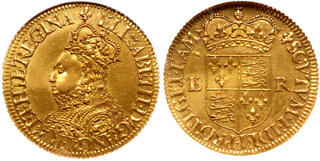| Ira & Larry Goldberg Coins & Collectibles > Auction 137 | Auction date: 29 January 2024 |
| Lot number: 1119 Price realized: 67,500 USD (Approx. 62,519 EUR) Note: Prices do not include buyer's fees. | Show similar lots on CoinArchives Find similar lots in upcoming auctions on |
| Lot description: Great Britain. Milled Half Pound, ND. S-2543; N-2019. 5.69 grams. Elizabeth I, 1558-1603. Milled Coinage (1565-1570). Coinage by Mestrelle, the monarch in jeweled dress, with curly "Z" in her name, and grained edge. Crowned bust left. Reverse; Crowned, square-topped shield. Lis mintmark (struck 1567-1570, era of the 3rd Coinage). A splendid example, rich with luster and mellow golden red toning, on a broad flan and showing intricate design details. Few exist of this caliber! Extremely rare as such. Pop 1; The only Example graded. NGC graded MS-62. Estimated Value $30,000 - UP Tower Mint, London. This coin features a famous coinage portrait of the queen wearing a ruff around her neck, her long hair seemingly studded with jewels, flowing from beneath her crown down the back of her neck, her dress elaborate and also jeweled. Her profile is dramatic and accurate to life. Above her near the rim is a "lis" initial mark. The reverse side shows a familiar motif that became the standard for her smaller gold coins: a quartered shield, crowned, holding the royal insignia, with her initials ER split to the sides. The "lis" again appears, here before one of Elizabeth's favored religious legends, in Latin SCVTVM FIDEI PROTEGET EAM, which in English means "The shield of faith shall protect her." The "lis" initial mark signifies that this coin was minted 1566-70 as part of what is called Elizabeth's Third Coinage period. This was relatively early in her long reign at a time when she was determined to rectify the debasement of English money which began when her father, King Henry VIII, raided his own treasury to pay for his personal excesses, and they were numerous. By contrast, his daughter was almost stingy and her desire was that all English coins issued in her name would be of high quality-that is, of a fineness of metal that would inspire confidence in the money as well as loyalty to her as queen. She also commanded that her Royal Mint would fashion her money well, with a sharpness of design that would be consistently well detailed. At the time, coins were made using an ancient technique involving individual "moneyers" at the mint holding one die while the other was settled into a block; when a blank piece of metal was placed on the lower die, the coiner would place the upper die on it and strike it with a hammer, often more than once. This produced coins of inconsistent quality, sometimes sharp here or there, sometimes struck off center with areas of weakness of design. About 1561 the Privy Council, which advised the queen and was the sole intermediary between the monarch and her various agencies of government, was approached by a man of great talent at minting-Eloye Mestrelle, a French moneyer who possessed some equipment that was not yet known in England. It was a "screw press" worked by two or more men who swung a long lever that caused the mechanism to close on a piece of metal held in place below it. The blank pieces of metal from which the coins were struck in this manner were made by another piece of machinery powered by a horse-drawn mill in another part of the mint. He called his novel money "mill" coinage, now known as "milled" by collectors. Elizabeth liked the idea and ordered her Privy Council to engage Mestrelle. He set up his equipment at the old Royal Mint inside the Tower of London and produced this special coinage from 1565-70. Unfortunately there was a downside to the story of his great success: the guild of old-time workers, who had hammered out coins for decades, felt so threatened by the Frenchman's inventiveness that they told their masters at the mint that the equipment was unreliable and slow, compared to their own work. They orchestrated Mestrelle's removal from the mint in 1572, but what was experimental in 1565 remained impressive to many eyes and within a century "milled coinage" would return and become the new standard in Great Britain. Ex Dr Jacob Y. Terner Collection (by private treaty to the Millennia Collection). Illustrated in Money of The World, coin 84; Ex Goldberg "Millennia" Sale 46, May 26, 2007, lot 296. |  |


